CQUniversity ACCT20075 Auditing Report: Financial Statement Analysis
VerifiedAdded on 2022/11/26
|13
|2651
|325
Report
AI Summary
This report presents an in-depth analysis of auditing concepts and procedures applied to a chosen company, likely Macquarie Group, based on the provided content. It begins by defining materiality, its significance in auditing financial statements, and methods for its calculation. The report then performs an analytical review of the company's financial statements from 2016 to 2019, assessing key ratios like asset turnover, liquidity, and profitability. It identifies key risk areas, audit assertions at risk, and corresponding audit procedures. The report also analyzes the company's cash flow statements, highlighting major cash inflows and outflows. Finally, it discusses the type of audit opinion and the key audit matters, including exploration expenditure and site rehabilitation, concluding with a summary of the audit's findings and its overall sustainability and transparency.
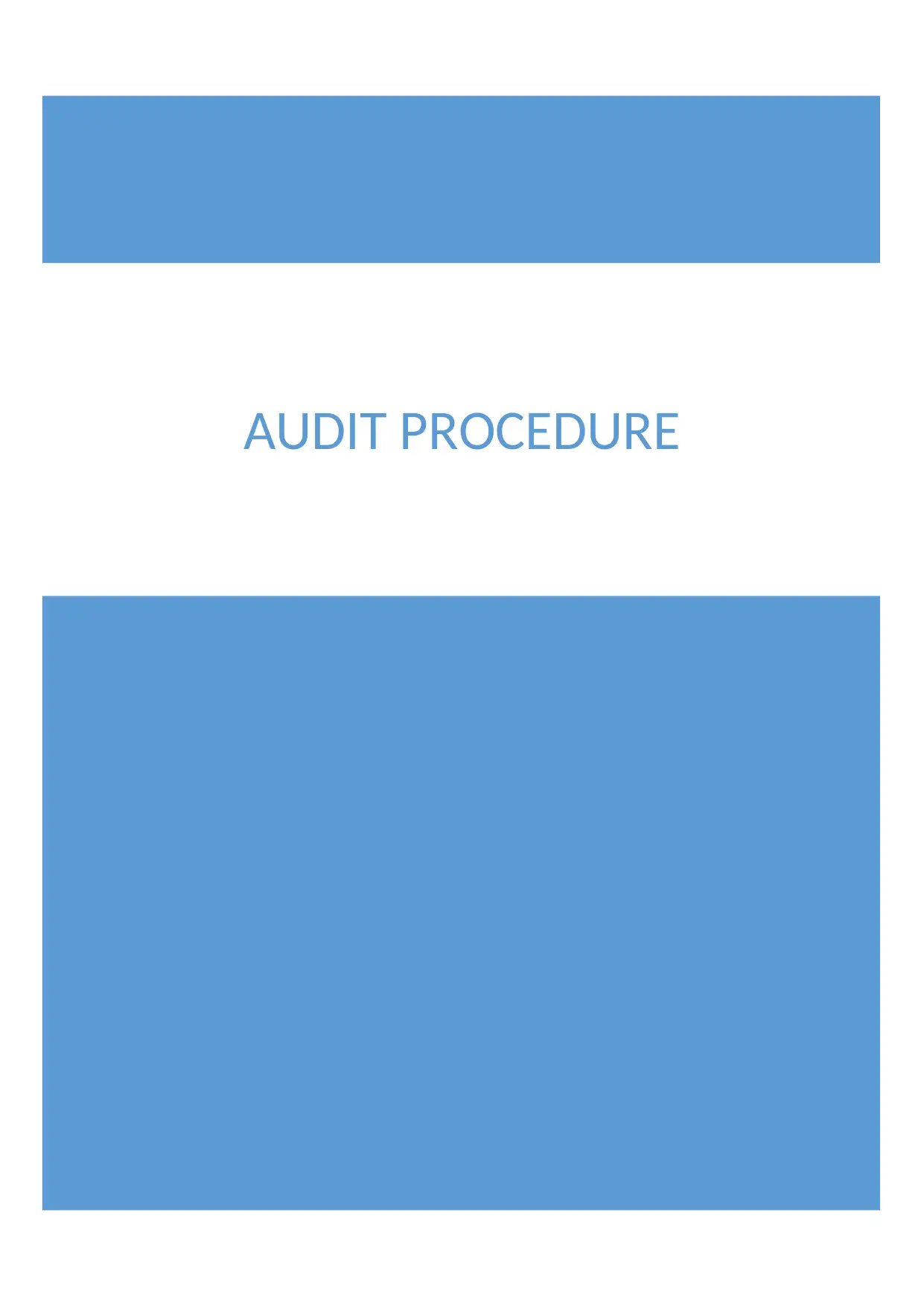
AUDIT PROCEDURE
Paraphrase This Document
Need a fresh take? Get an instant paraphrase of this document with our AI Paraphraser
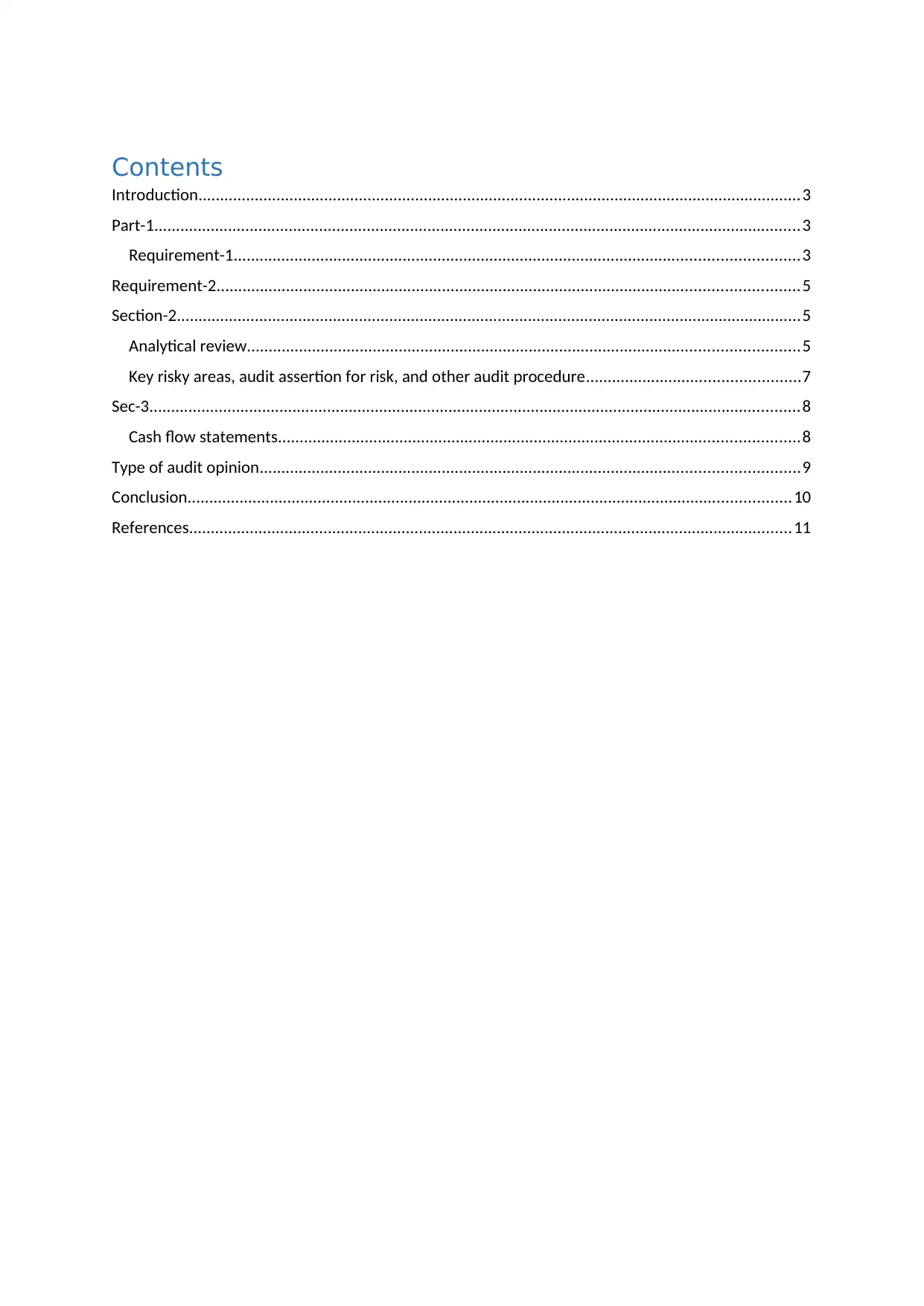
Contents
Introduction...........................................................................................................................................3
Part-1.....................................................................................................................................................3
Requirement-1..................................................................................................................................3
Requirement-2......................................................................................................................................5
Section-2................................................................................................................................................5
Analytical review...............................................................................................................................5
Key risky areas, audit assertion for risk, and other audit procedure.................................................7
Sec-3......................................................................................................................................................8
Cash flow statements........................................................................................................................8
Type of audit opinion............................................................................................................................9
Conclusion...........................................................................................................................................10
References...........................................................................................................................................11
Introduction...........................................................................................................................................3
Part-1.....................................................................................................................................................3
Requirement-1..................................................................................................................................3
Requirement-2......................................................................................................................................5
Section-2................................................................................................................................................5
Analytical review...............................................................................................................................5
Key risky areas, audit assertion for risk, and other audit procedure.................................................7
Sec-3......................................................................................................................................................8
Cash flow statements........................................................................................................................8
Type of audit opinion............................................................................................................................9
Conclusion...........................................................................................................................................10
References...........................................................................................................................................11
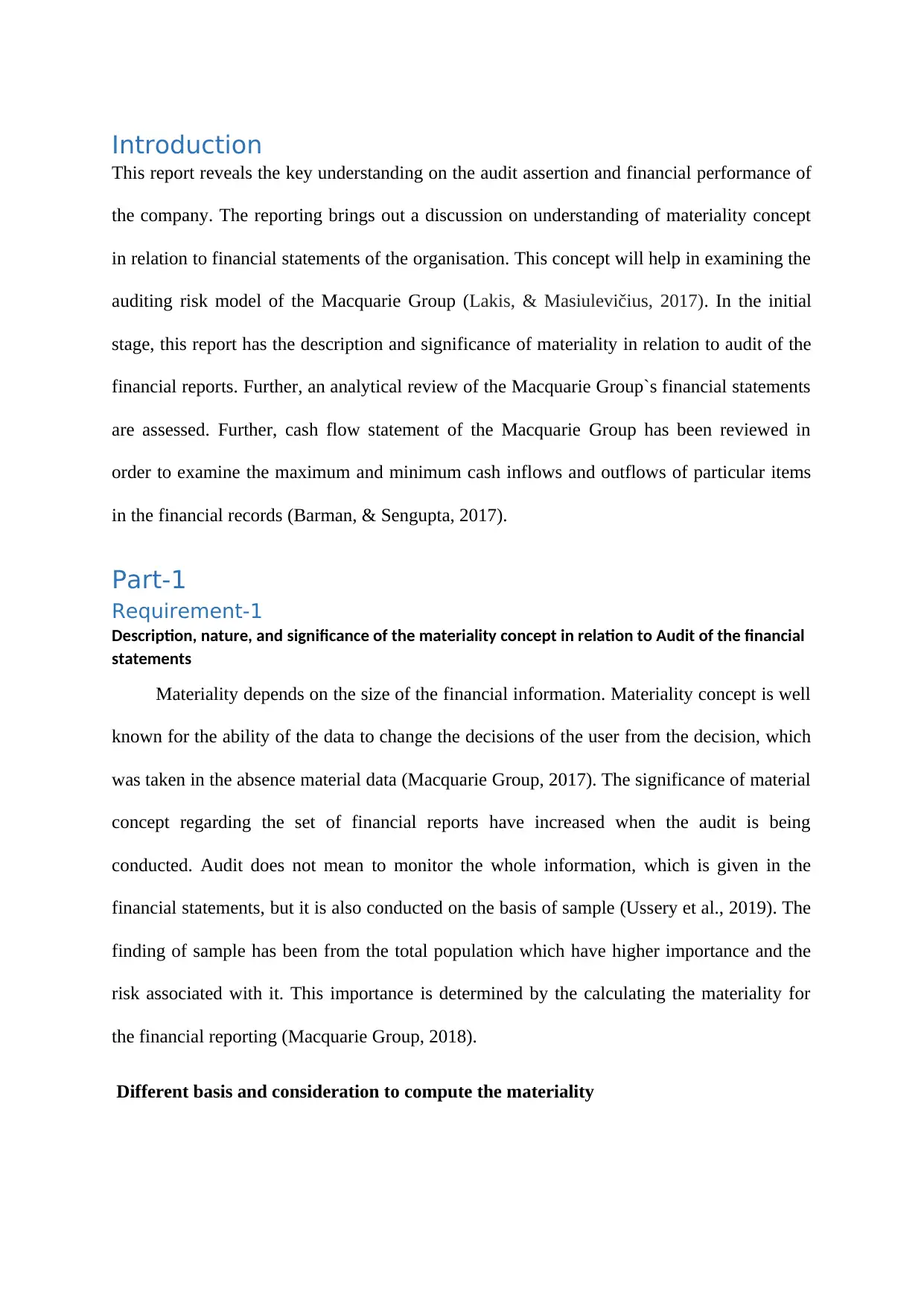
Introduction
This report reveals the key understanding on the audit assertion and financial performance of
the company. The reporting brings out a discussion on understanding of materiality concept
in relation to financial statements of the organisation. This concept will help in examining the
auditing risk model of the Macquarie Group (Lakis, & Masiulevičius, 2017). In the initial
stage, this report has the description and significance of materiality in relation to audit of the
financial reports. Further, an analytical review of the Macquarie Group`s financial statements
are assessed. Further, cash flow statement of the Macquarie Group has been reviewed in
order to examine the maximum and minimum cash inflows and outflows of particular items
in the financial records (Barman, & Sengupta, 2017).
Part-1
Requirement-1
Description, nature, and significance of the materiality concept in relation to Audit of the financial
statements
Materiality depends on the size of the financial information. Materiality concept is well
known for the ability of the data to change the decisions of the user from the decision, which
was taken in the absence material data (Macquarie Group, 2017). The significance of material
concept regarding the set of financial reports have increased when the audit is being
conducted. Audit does not mean to monitor the whole information, which is given in the
financial statements, but it is also conducted on the basis of sample (Ussery et al., 2019). The
finding of sample has been from the total population which have higher importance and the
risk associated with it. This importance is determined by the calculating the materiality for
the financial reporting (Macquarie Group, 2018).
Different basis and consideration to compute the materiality
This report reveals the key understanding on the audit assertion and financial performance of
the company. The reporting brings out a discussion on understanding of materiality concept
in relation to financial statements of the organisation. This concept will help in examining the
auditing risk model of the Macquarie Group (Lakis, & Masiulevičius, 2017). In the initial
stage, this report has the description and significance of materiality in relation to audit of the
financial reports. Further, an analytical review of the Macquarie Group`s financial statements
are assessed. Further, cash flow statement of the Macquarie Group has been reviewed in
order to examine the maximum and minimum cash inflows and outflows of particular items
in the financial records (Barman, & Sengupta, 2017).
Part-1
Requirement-1
Description, nature, and significance of the materiality concept in relation to Audit of the financial
statements
Materiality depends on the size of the financial information. Materiality concept is well
known for the ability of the data to change the decisions of the user from the decision, which
was taken in the absence material data (Macquarie Group, 2017). The significance of material
concept regarding the set of financial reports have increased when the audit is being
conducted. Audit does not mean to monitor the whole information, which is given in the
financial statements, but it is also conducted on the basis of sample (Ussery et al., 2019). The
finding of sample has been from the total population which have higher importance and the
risk associated with it. This importance is determined by the calculating the materiality for
the financial reporting (Macquarie Group, 2018).
Different basis and consideration to compute the materiality
⊘ This is a preview!⊘
Do you want full access?
Subscribe today to unlock all pages.

Trusted by 1+ million students worldwide
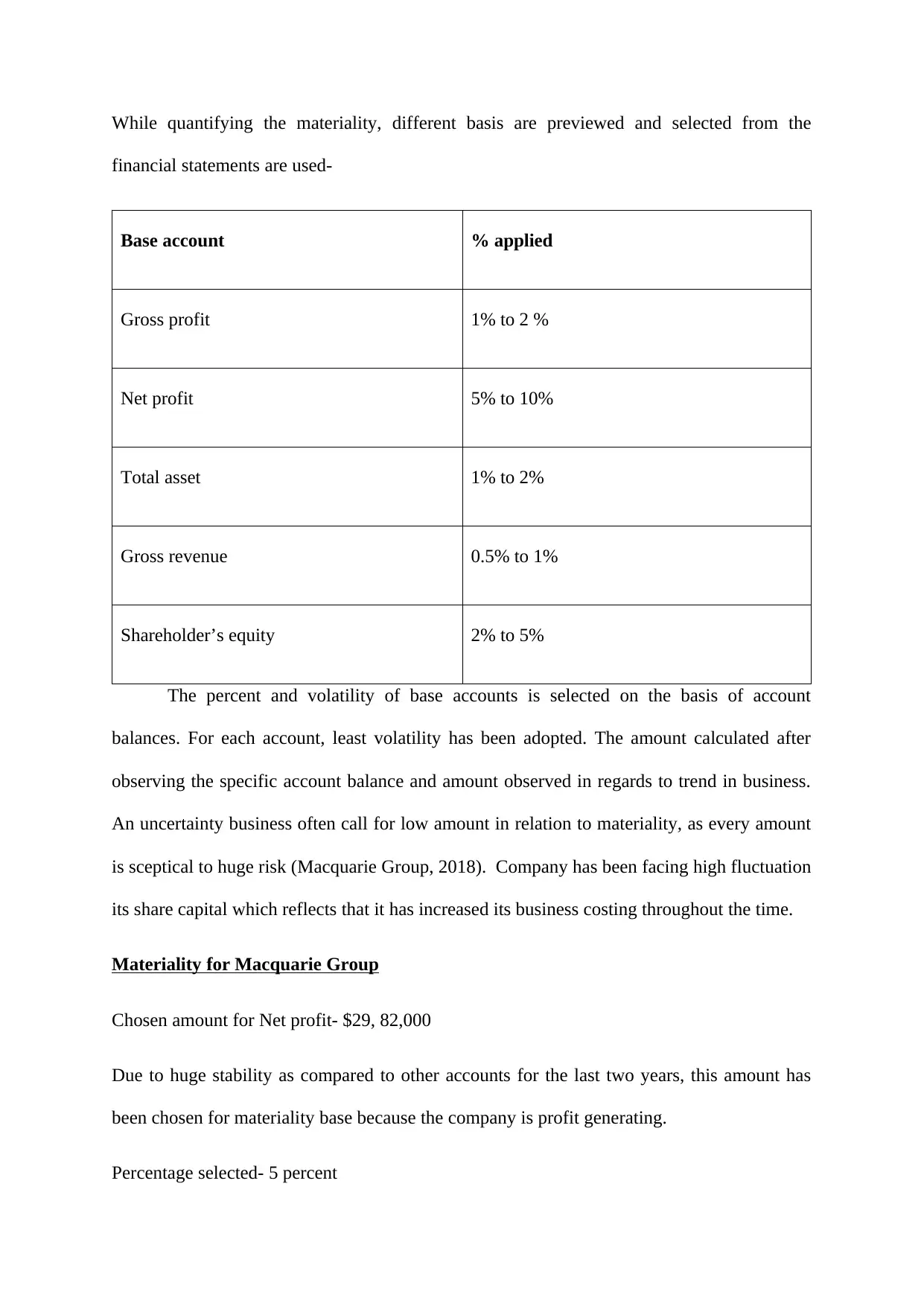
While quantifying the materiality, different basis are previewed and selected from the
financial statements are used-
Base account % applied
Gross profit 1% to 2 %
Net profit 5% to 10%
Total asset 1% to 2%
Gross revenue 0.5% to 1%
Shareholder’s equity 2% to 5%
The percent and volatility of base accounts is selected on the basis of account
balances. For each account, least volatility has been adopted. The amount calculated after
observing the specific account balance and amount observed in regards to trend in business.
An uncertainty business often call for low amount in relation to materiality, as every amount
is sceptical to huge risk (Macquarie Group, 2018). Company has been facing high fluctuation
its share capital which reflects that it has increased its business costing throughout the time.
Materiality for Macquarie Group
Chosen amount for Net profit- $29, 82,000
Due to huge stability as compared to other accounts for the last two years, this amount has
been chosen for materiality base because the company is profit generating.
Percentage selected- 5 percent
financial statements are used-
Base account % applied
Gross profit 1% to 2 %
Net profit 5% to 10%
Total asset 1% to 2%
Gross revenue 0.5% to 1%
Shareholder’s equity 2% to 5%
The percent and volatility of base accounts is selected on the basis of account
balances. For each account, least volatility has been adopted. The amount calculated after
observing the specific account balance and amount observed in regards to trend in business.
An uncertainty business often call for low amount in relation to materiality, as every amount
is sceptical to huge risk (Macquarie Group, 2018). Company has been facing high fluctuation
its share capital which reflects that it has increased its business costing throughout the time.
Materiality for Macquarie Group
Chosen amount for Net profit- $29, 82,000
Due to huge stability as compared to other accounts for the last two years, this amount has
been chosen for materiality base because the company is profit generating.
Percentage selected- 5 percent
Paraphrase This Document
Need a fresh take? Get an instant paraphrase of this document with our AI Paraphraser
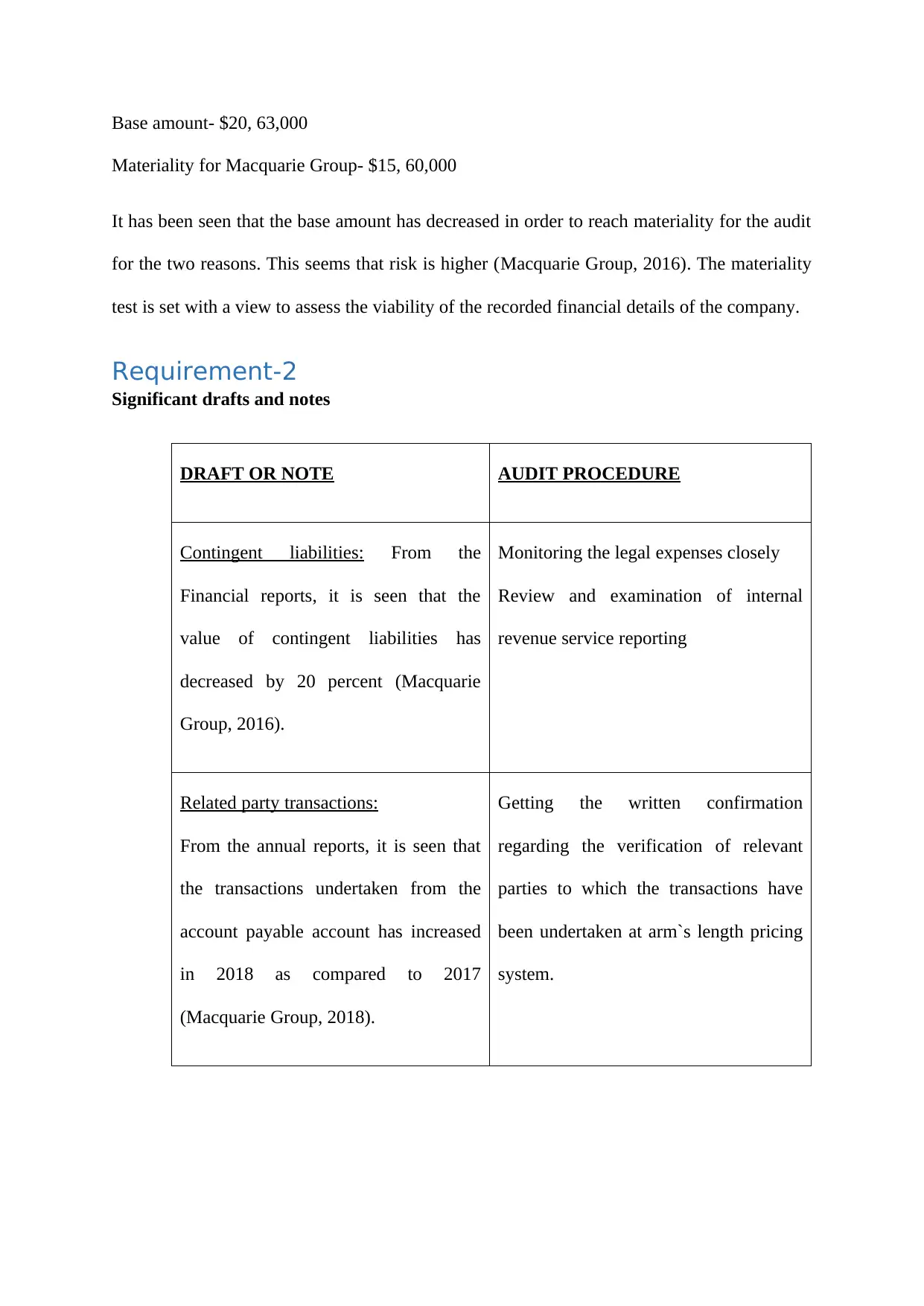
Base amount- $20, 63,000
Materiality for Macquarie Group- $15, 60,000
It has been seen that the base amount has decreased in order to reach materiality for the audit
for the two reasons. This seems that risk is higher (Macquarie Group, 2016). The materiality
test is set with a view to assess the viability of the recorded financial details of the company.
Requirement-2
Significant drafts and notes
DRAFT OR NOTE AUDIT PROCEDURE
Contingent liabilities: From the
Financial reports, it is seen that the
value of contingent liabilities has
decreased by 20 percent (Macquarie
Group, 2016).
Monitoring the legal expenses closely
Review and examination of internal
revenue service reporting
Related party transactions:
From the annual reports, it is seen that
the transactions undertaken from the
account payable account has increased
in 2018 as compared to 2017
(Macquarie Group, 2018).
Getting the written confirmation
regarding the verification of relevant
parties to which the transactions have
been undertaken at arm`s length pricing
system.
Materiality for Macquarie Group- $15, 60,000
It has been seen that the base amount has decreased in order to reach materiality for the audit
for the two reasons. This seems that risk is higher (Macquarie Group, 2016). The materiality
test is set with a view to assess the viability of the recorded financial details of the company.
Requirement-2
Significant drafts and notes
DRAFT OR NOTE AUDIT PROCEDURE
Contingent liabilities: From the
Financial reports, it is seen that the
value of contingent liabilities has
decreased by 20 percent (Macquarie
Group, 2016).
Monitoring the legal expenses closely
Review and examination of internal
revenue service reporting
Related party transactions:
From the annual reports, it is seen that
the transactions undertaken from the
account payable account has increased
in 2018 as compared to 2017
(Macquarie Group, 2018).
Getting the written confirmation
regarding the verification of relevant
parties to which the transactions have
been undertaken at arm`s length pricing
system.
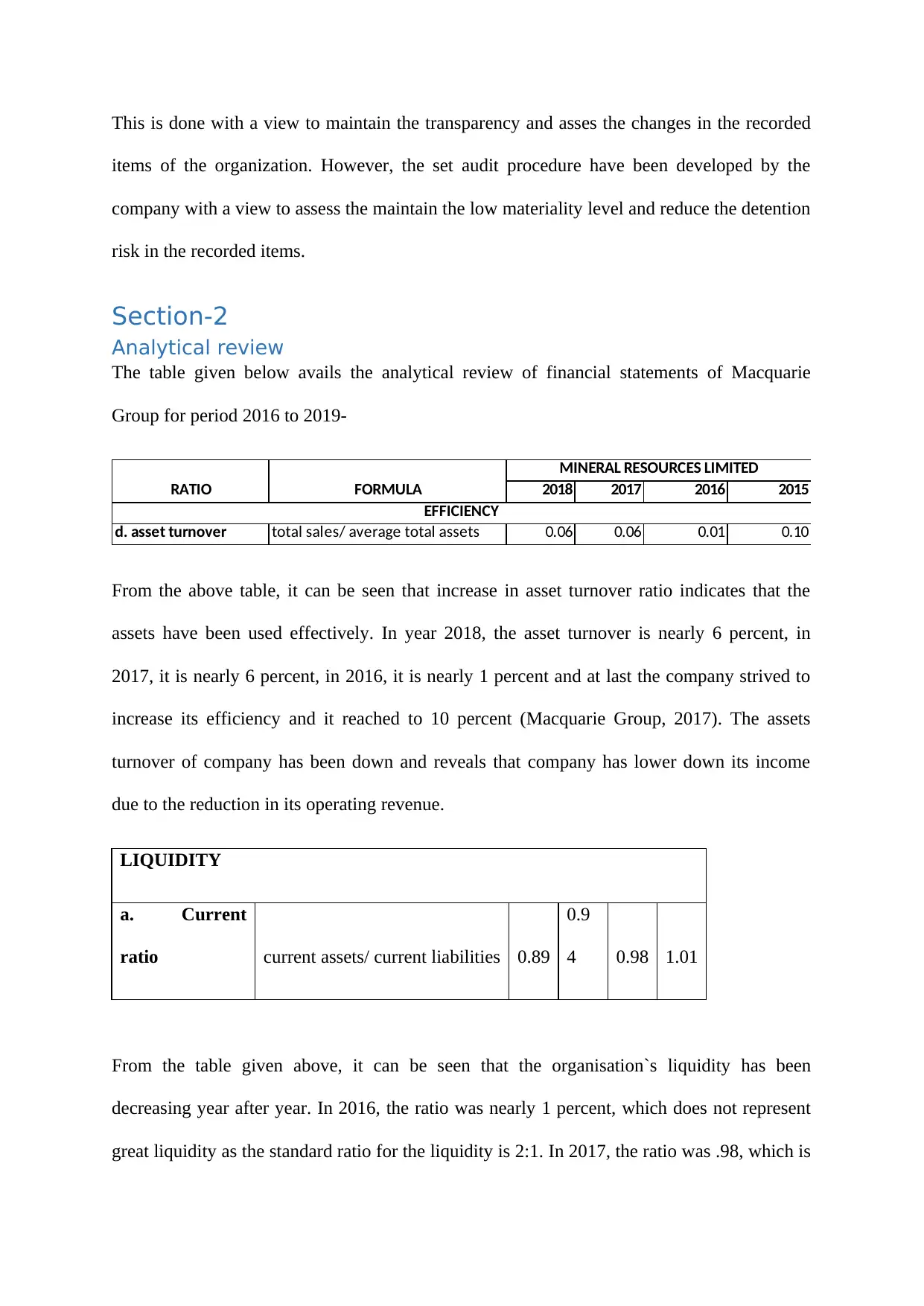
This is done with a view to maintain the transparency and asses the changes in the recorded
items of the organization. However, the set audit procedure have been developed by the
company with a view to assess the maintain the low materiality level and reduce the detention
risk in the recorded items.
Section-2
Analytical review
The table given below avails the analytical review of financial statements of Macquarie
Group for period 2016 to 2019-
2018 2017 2016 2015
d. asset turnover total sales/ average total assets 0.06 0.06 0.01 0.10
RATIO FORMULA
MINERAL RESOURCES LIMITED
EFFICIENCY
From the above table, it can be seen that increase in asset turnover ratio indicates that the
assets have been used effectively. In year 2018, the asset turnover is nearly 6 percent, in
2017, it is nearly 6 percent, in 2016, it is nearly 1 percent and at last the company strived to
increase its efficiency and it reached to 10 percent (Macquarie Group, 2017). The assets
turnover of company has been down and reveals that company has lower down its income
due to the reduction in its operating revenue.
LIQUIDITY
a. Current
ratio current assets/ current liabilities 0.89
0.9
4 0.98 1.01
From the table given above, it can be seen that the organisation`s liquidity has been
decreasing year after year. In 2016, the ratio was nearly 1 percent, which does not represent
great liquidity as the standard ratio for the liquidity is 2:1. In 2017, the ratio was .98, which is
items of the organization. However, the set audit procedure have been developed by the
company with a view to assess the maintain the low materiality level and reduce the detention
risk in the recorded items.
Section-2
Analytical review
The table given below avails the analytical review of financial statements of Macquarie
Group for period 2016 to 2019-
2018 2017 2016 2015
d. asset turnover total sales/ average total assets 0.06 0.06 0.01 0.10
RATIO FORMULA
MINERAL RESOURCES LIMITED
EFFICIENCY
From the above table, it can be seen that increase in asset turnover ratio indicates that the
assets have been used effectively. In year 2018, the asset turnover is nearly 6 percent, in
2017, it is nearly 6 percent, in 2016, it is nearly 1 percent and at last the company strived to
increase its efficiency and it reached to 10 percent (Macquarie Group, 2017). The assets
turnover of company has been down and reveals that company has lower down its income
due to the reduction in its operating revenue.
LIQUIDITY
a. Current
ratio current assets/ current liabilities 0.89
0.9
4 0.98 1.01
From the table given above, it can be seen that the organisation`s liquidity has been
decreasing year after year. In 2016, the ratio was nearly 1 percent, which does not represent
great liquidity as the standard ratio for the liquidity is 2:1. In 2017, the ratio was .98, which is
⊘ This is a preview!⊘
Do you want full access?
Subscribe today to unlock all pages.

Trusted by 1+ million students worldwide
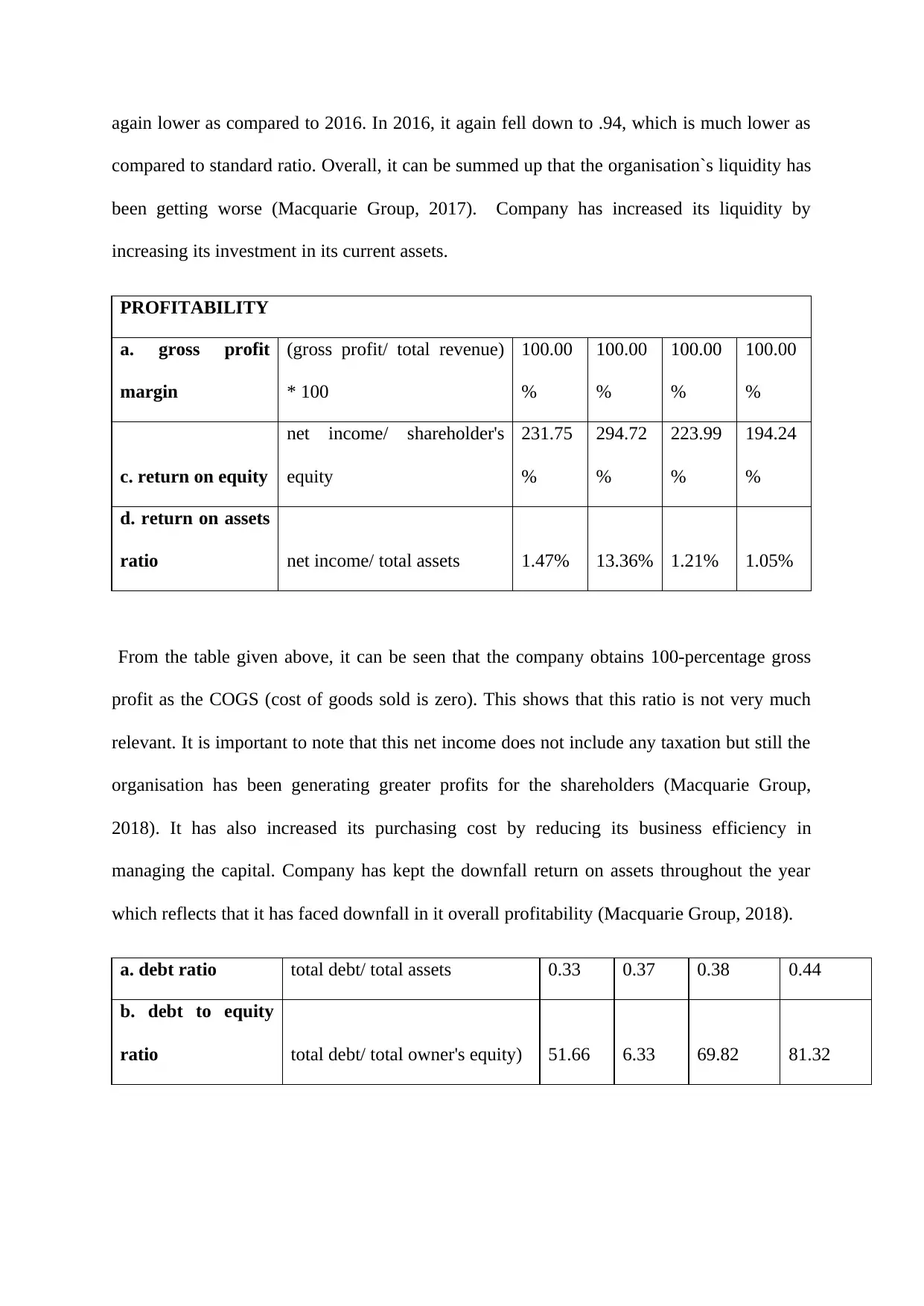
again lower as compared to 2016. In 2016, it again fell down to .94, which is much lower as
compared to standard ratio. Overall, it can be summed up that the organisation`s liquidity has
been getting worse (Macquarie Group, 2017). Company has increased its liquidity by
increasing its investment in its current assets.
PROFITABILITY
a. gross profit
margin
(gross profit/ total revenue)
* 100
100.00
%
100.00
%
100.00
%
100.00
%
c. return on equity
net income/ shareholder's
equity
231.75
%
294.72
%
223.99
%
194.24
%
d. return on assets
ratio net income/ total assets 1.47% 13.36% 1.21% 1.05%
From the table given above, it can be seen that the company obtains 100-percentage gross
profit as the COGS (cost of goods sold is zero). This shows that this ratio is not very much
relevant. It is important to note that this net income does not include any taxation but still the
organisation has been generating greater profits for the shareholders (Macquarie Group,
2018). It has also increased its purchasing cost by reducing its business efficiency in
managing the capital. Company has kept the downfall return on assets throughout the year
which reflects that it has faced downfall in it overall profitability (Macquarie Group, 2018).
a. debt ratio total debt/ total assets 0.33 0.37 0.38 0.44
b. debt to equity
ratio total debt/ total owner's equity) 51.66 6.33 69.82 81.32
compared to standard ratio. Overall, it can be summed up that the organisation`s liquidity has
been getting worse (Macquarie Group, 2017). Company has increased its liquidity by
increasing its investment in its current assets.
PROFITABILITY
a. gross profit
margin
(gross profit/ total revenue)
* 100
100.00
%
100.00
%
100.00
%
100.00
%
c. return on equity
net income/ shareholder's
equity
231.75
%
294.72
%
223.99
%
194.24
%
d. return on assets
ratio net income/ total assets 1.47% 13.36% 1.21% 1.05%
From the table given above, it can be seen that the company obtains 100-percentage gross
profit as the COGS (cost of goods sold is zero). This shows that this ratio is not very much
relevant. It is important to note that this net income does not include any taxation but still the
organisation has been generating greater profits for the shareholders (Macquarie Group,
2018). It has also increased its purchasing cost by reducing its business efficiency in
managing the capital. Company has kept the downfall return on assets throughout the year
which reflects that it has faced downfall in it overall profitability (Macquarie Group, 2018).
a. debt ratio total debt/ total assets 0.33 0.37 0.38 0.44
b. debt to equity
ratio total debt/ total owner's equity) 51.66 6.33 69.82 81.32
Paraphrase This Document
Need a fresh take? Get an instant paraphrase of this document with our AI Paraphraser
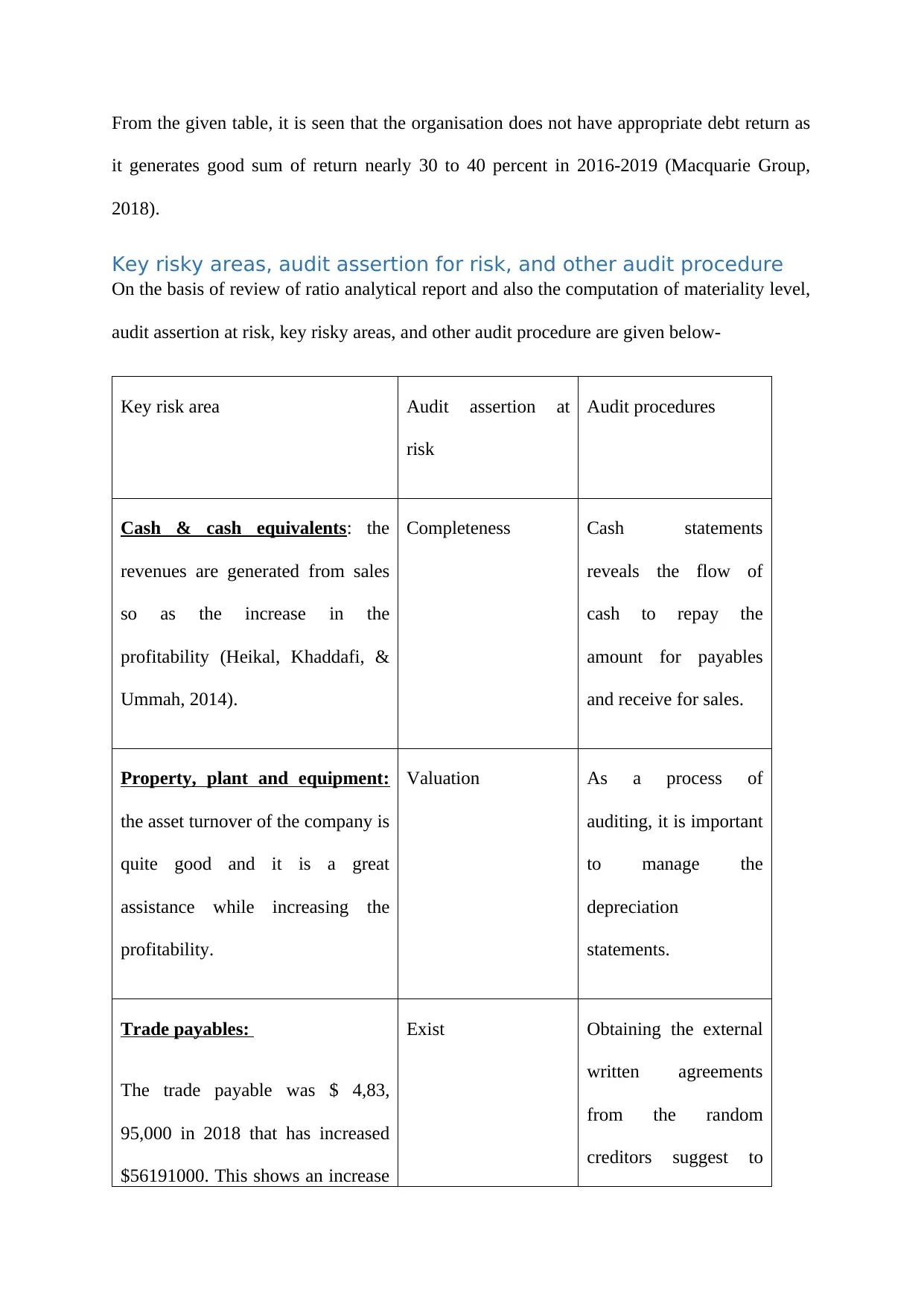
From the given table, it is seen that the organisation does not have appropriate debt return as
it generates good sum of return nearly 30 to 40 percent in 2016-2019 (Macquarie Group,
2018).
Key risky areas, audit assertion for risk, and other audit procedure
On the basis of review of ratio analytical report and also the computation of materiality level,
audit assertion at risk, key risky areas, and other audit procedure are given below-
Key risk area Audit assertion at
risk
Audit procedures
Cash & cash equivalents: the
revenues are generated from sales
so as the increase in the
profitability (Heikal, Khaddafi, &
Ummah, 2014).
Completeness Cash statements
reveals the flow of
cash to repay the
amount for payables
and receive for sales.
Property, plant and equipment:
the asset turnover of the company is
quite good and it is a great
assistance while increasing the
profitability.
Valuation As a process of
auditing, it is important
to manage the
depreciation
statements.
Trade payables:
The trade payable was $ 4,83,
95,000 in 2018 that has increased
$56191000. This shows an increase
Exist Obtaining the external
written agreements
from the random
creditors suggest to
it generates good sum of return nearly 30 to 40 percent in 2016-2019 (Macquarie Group,
2018).
Key risky areas, audit assertion for risk, and other audit procedure
On the basis of review of ratio analytical report and also the computation of materiality level,
audit assertion at risk, key risky areas, and other audit procedure are given below-
Key risk area Audit assertion at
risk
Audit procedures
Cash & cash equivalents: the
revenues are generated from sales
so as the increase in the
profitability (Heikal, Khaddafi, &
Ummah, 2014).
Completeness Cash statements
reveals the flow of
cash to repay the
amount for payables
and receive for sales.
Property, plant and equipment:
the asset turnover of the company is
quite good and it is a great
assistance while increasing the
profitability.
Valuation As a process of
auditing, it is important
to manage the
depreciation
statements.
Trade payables:
The trade payable was $ 4,83,
95,000 in 2018 that has increased
$56191000. This shows an increase
Exist Obtaining the external
written agreements
from the random
creditors suggest to
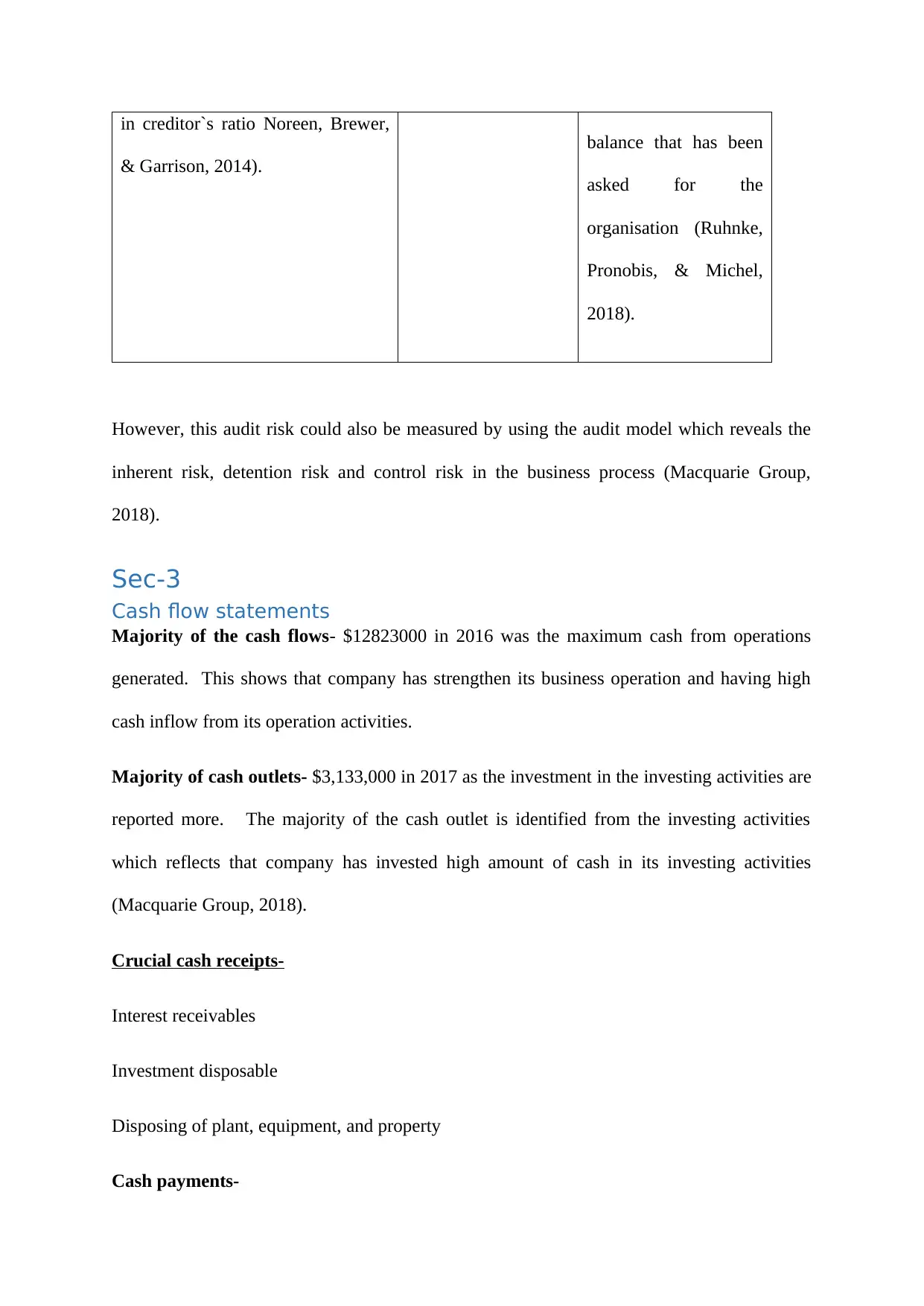
in creditor`s ratio Noreen, Brewer,
& Garrison, 2014).
balance that has been
asked for the
organisation (Ruhnke,
Pronobis, & Michel,
2018).
However, this audit risk could also be measured by using the audit model which reveals the
inherent risk, detention risk and control risk in the business process (Macquarie Group,
2018).
Sec-3
Cash flow statements
Majority of the cash flows- $12823000 in 2016 was the maximum cash from operations
generated. This shows that company has strengthen its business operation and having high
cash inflow from its operation activities.
Majority of cash outlets- $3,133,000 in 2017 as the investment in the investing activities are
reported more. The majority of the cash outlet is identified from the investing activities
which reflects that company has invested high amount of cash in its investing activities
(Macquarie Group, 2018).
Crucial cash receipts-
Interest receivables
Investment disposable
Disposing of plant, equipment, and property
Cash payments-
& Garrison, 2014).
balance that has been
asked for the
organisation (Ruhnke,
Pronobis, & Michel,
2018).
However, this audit risk could also be measured by using the audit model which reveals the
inherent risk, detention risk and control risk in the business process (Macquarie Group,
2018).
Sec-3
Cash flow statements
Majority of the cash flows- $12823000 in 2016 was the maximum cash from operations
generated. This shows that company has strengthen its business operation and having high
cash inflow from its operation activities.
Majority of cash outlets- $3,133,000 in 2017 as the investment in the investing activities are
reported more. The majority of the cash outlet is identified from the investing activities
which reflects that company has invested high amount of cash in its investing activities
(Macquarie Group, 2018).
Crucial cash receipts-
Interest receivables
Investment disposable
Disposing of plant, equipment, and property
Cash payments-
⊘ This is a preview!⊘
Do you want full access?
Subscribe today to unlock all pages.

Trusted by 1+ million students worldwide
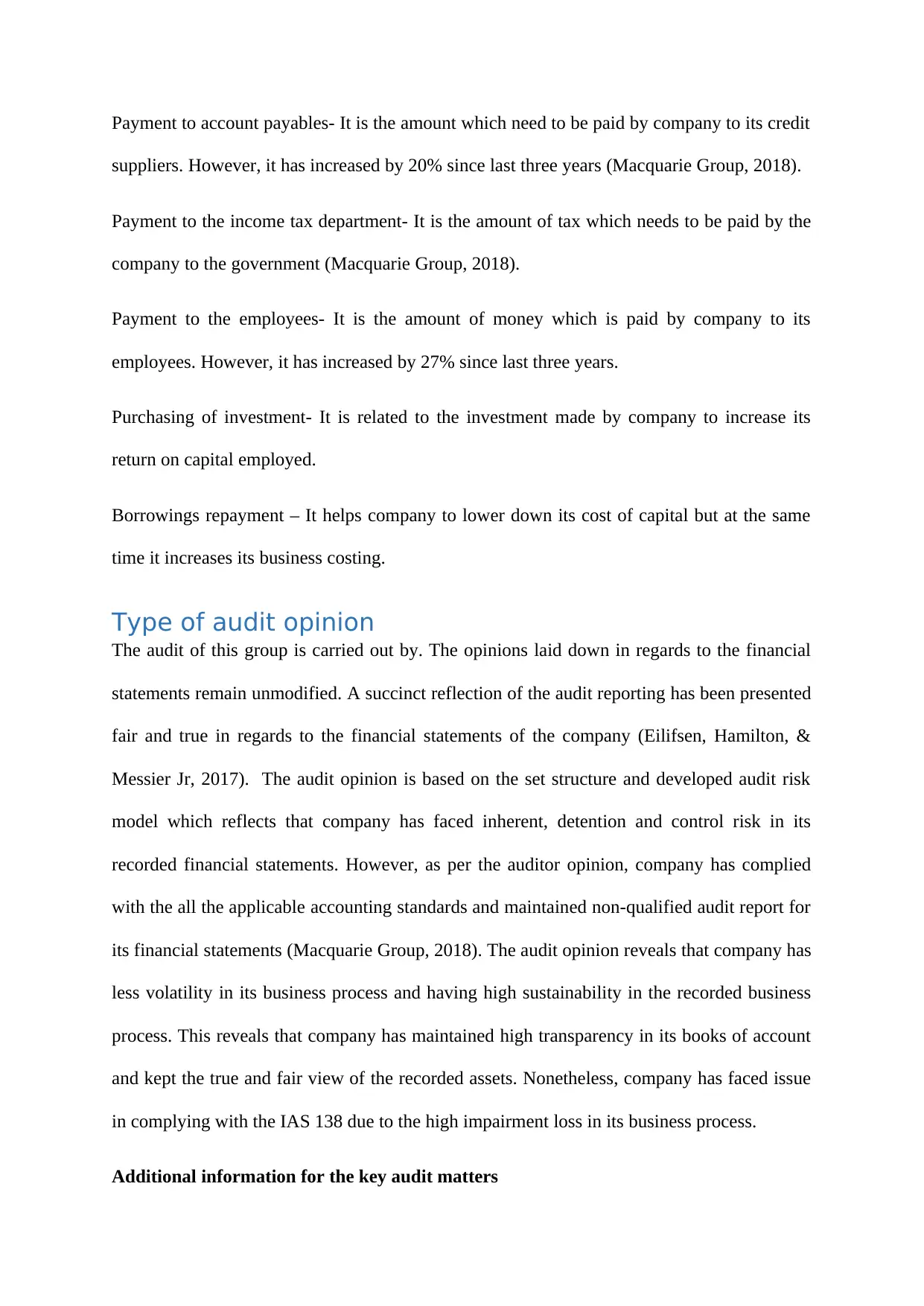
Payment to account payables- It is the amount which need to be paid by company to its credit
suppliers. However, it has increased by 20% since last three years (Macquarie Group, 2018).
Payment to the income tax department- It is the amount of tax which needs to be paid by the
company to the government (Macquarie Group, 2018).
Payment to the employees- It is the amount of money which is paid by company to its
employees. However, it has increased by 27% since last three years.
Purchasing of investment- It is related to the investment made by company to increase its
return on capital employed.
Borrowings repayment – It helps company to lower down its cost of capital but at the same
time it increases its business costing.
Type of audit opinion
The audit of this group is carried out by. The opinions laid down in regards to the financial
statements remain unmodified. A succinct reflection of the audit reporting has been presented
fair and true in regards to the financial statements of the company (Eilifsen, Hamilton, &
Messier Jr, 2017). The audit opinion is based on the set structure and developed audit risk
model which reflects that company has faced inherent, detention and control risk in its
recorded financial statements. However, as per the auditor opinion, company has complied
with the all the applicable accounting standards and maintained non-qualified audit report for
its financial statements (Macquarie Group, 2018). The audit opinion reveals that company has
less volatility in its business process and having high sustainability in the recorded business
process. This reveals that company has maintained high transparency in its books of account
and kept the true and fair view of the recorded assets. Nonetheless, company has faced issue
in complying with the IAS 138 due to the high impairment loss in its business process.
Additional information for the key audit matters
suppliers. However, it has increased by 20% since last three years (Macquarie Group, 2018).
Payment to the income tax department- It is the amount of tax which needs to be paid by the
company to the government (Macquarie Group, 2018).
Payment to the employees- It is the amount of money which is paid by company to its
employees. However, it has increased by 27% since last three years.
Purchasing of investment- It is related to the investment made by company to increase its
return on capital employed.
Borrowings repayment – It helps company to lower down its cost of capital but at the same
time it increases its business costing.
Type of audit opinion
The audit of this group is carried out by. The opinions laid down in regards to the financial
statements remain unmodified. A succinct reflection of the audit reporting has been presented
fair and true in regards to the financial statements of the company (Eilifsen, Hamilton, &
Messier Jr, 2017). The audit opinion is based on the set structure and developed audit risk
model which reflects that company has faced inherent, detention and control risk in its
recorded financial statements. However, as per the auditor opinion, company has complied
with the all the applicable accounting standards and maintained non-qualified audit report for
its financial statements (Macquarie Group, 2018). The audit opinion reveals that company has
less volatility in its business process and having high sustainability in the recorded business
process. This reveals that company has maintained high transparency in its books of account
and kept the true and fair view of the recorded assets. Nonetheless, company has faced issue
in complying with the IAS 138 due to the high impairment loss in its business process.
Additional information for the key audit matters
Paraphrase This Document
Need a fresh take? Get an instant paraphrase of this document with our AI Paraphraser
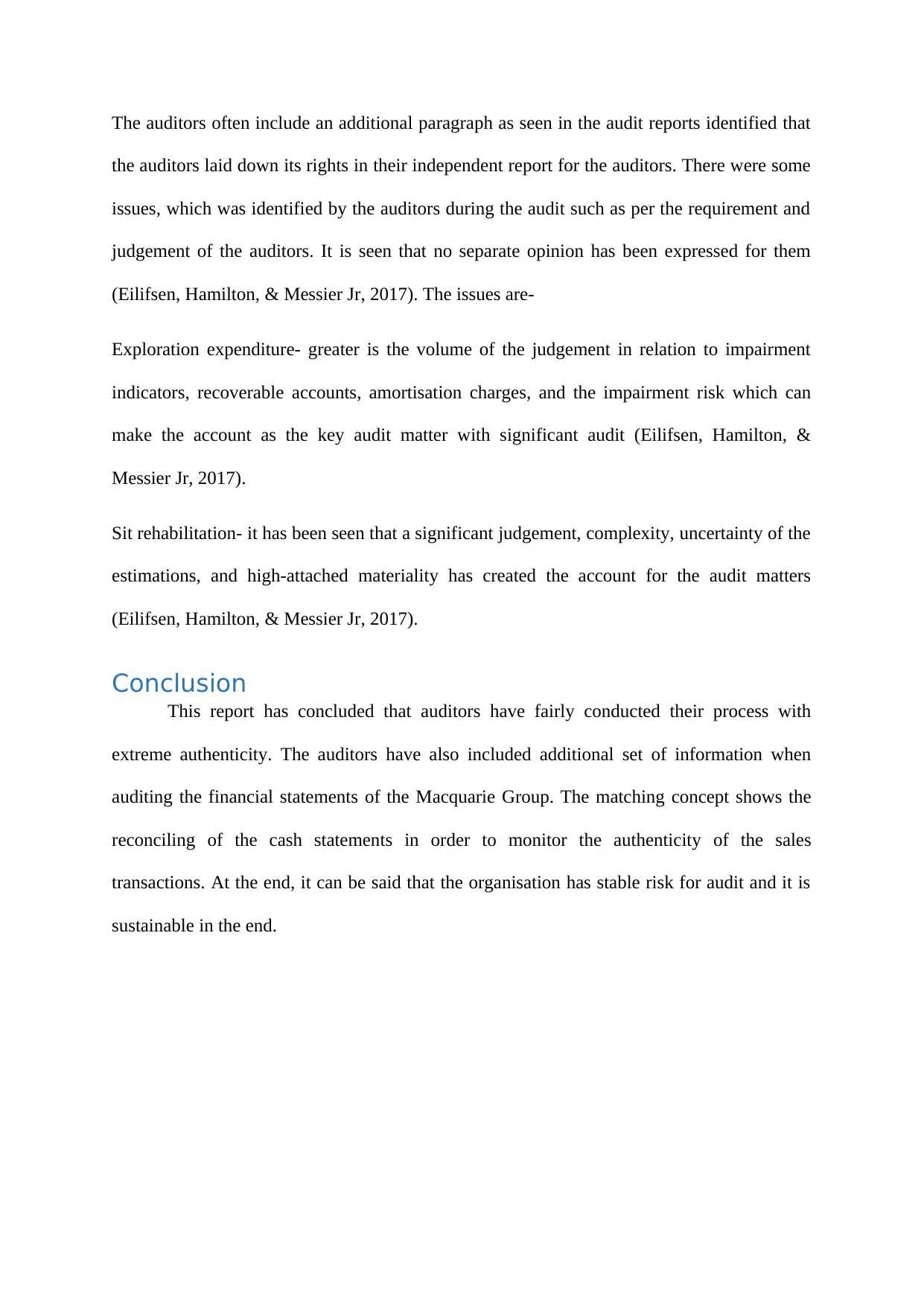
The auditors often include an additional paragraph as seen in the audit reports identified that
the auditors laid down its rights in their independent report for the auditors. There were some
issues, which was identified by the auditors during the audit such as per the requirement and
judgement of the auditors. It is seen that no separate opinion has been expressed for them
(Eilifsen, Hamilton, & Messier Jr, 2017). The issues are-
Exploration expenditure- greater is the volume of the judgement in relation to impairment
indicators, recoverable accounts, amortisation charges, and the impairment risk which can
make the account as the key audit matter with significant audit (Eilifsen, Hamilton, &
Messier Jr, 2017).
Sit rehabilitation- it has been seen that a significant judgement, complexity, uncertainty of the
estimations, and high-attached materiality has created the account for the audit matters
(Eilifsen, Hamilton, & Messier Jr, 2017).
Conclusion
This report has concluded that auditors have fairly conducted their process with
extreme authenticity. The auditors have also included additional set of information when
auditing the financial statements of the Macquarie Group. The matching concept shows the
reconciling of the cash statements in order to monitor the authenticity of the sales
transactions. At the end, it can be said that the organisation has stable risk for audit and it is
sustainable in the end.
the auditors laid down its rights in their independent report for the auditors. There were some
issues, which was identified by the auditors during the audit such as per the requirement and
judgement of the auditors. It is seen that no separate opinion has been expressed for them
(Eilifsen, Hamilton, & Messier Jr, 2017). The issues are-
Exploration expenditure- greater is the volume of the judgement in relation to impairment
indicators, recoverable accounts, amortisation charges, and the impairment risk which can
make the account as the key audit matter with significant audit (Eilifsen, Hamilton, &
Messier Jr, 2017).
Sit rehabilitation- it has been seen that a significant judgement, complexity, uncertainty of the
estimations, and high-attached materiality has created the account for the audit matters
(Eilifsen, Hamilton, & Messier Jr, 2017).
Conclusion
This report has concluded that auditors have fairly conducted their process with
extreme authenticity. The auditors have also included additional set of information when
auditing the financial statements of the Macquarie Group. The matching concept shows the
reconciling of the cash statements in order to monitor the authenticity of the sales
transactions. At the end, it can be said that the organisation has stable risk for audit and it is
sustainable in the end.
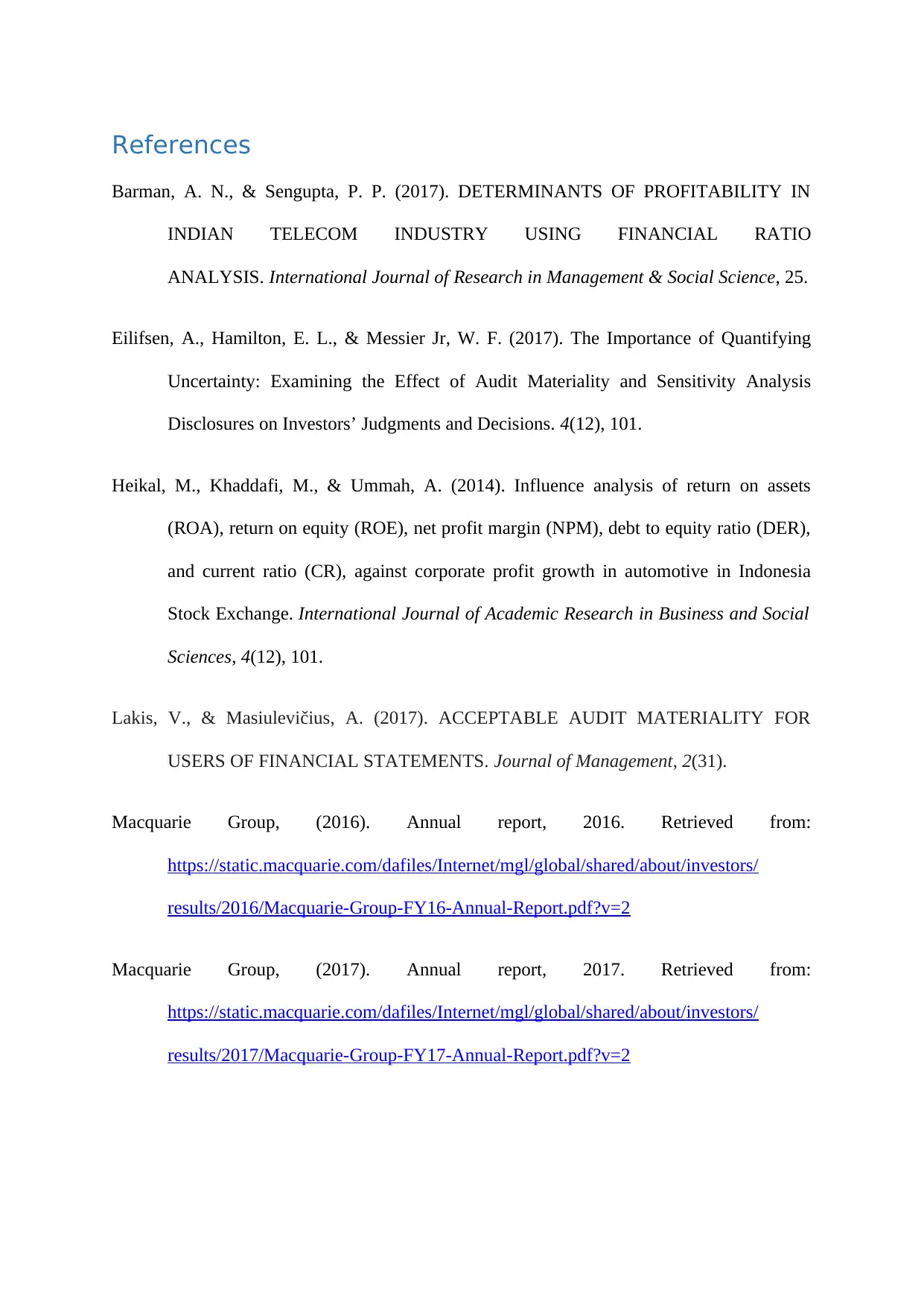
References
Barman, A. N., & Sengupta, P. P. (2017). DETERMINANTS OF PROFITABILITY IN
INDIAN TELECOM INDUSTRY USING FINANCIAL RATIO
ANALYSIS. International Journal of Research in Management & Social Science, 25.
Eilifsen, A., Hamilton, E. L., & Messier Jr, W. F. (2017). The Importance of Quantifying
Uncertainty: Examining the Effect of Audit Materiality and Sensitivity Analysis
Disclosures on Investors’ Judgments and Decisions. 4(12), 101.
Heikal, M., Khaddafi, M., & Ummah, A. (2014). Influence analysis of return on assets
(ROA), return on equity (ROE), net profit margin (NPM), debt to equity ratio (DER),
and current ratio (CR), against corporate profit growth in automotive in Indonesia
Stock Exchange. International Journal of Academic Research in Business and Social
Sciences, 4(12), 101.
Lakis, V., & Masiulevičius, A. (2017). ACCEPTABLE AUDIT MATERIALITY FOR
USERS OF FINANCIAL STATEMENTS. Journal of Management, 2(31).
Macquarie Group, (2016). Annual report, 2016. Retrieved from:
https://static.macquarie.com/dafiles/Internet/mgl/global/shared/about/investors/
results/2016/Macquarie-Group-FY16-Annual-Report.pdf?v=2
Macquarie Group, (2017). Annual report, 2017. Retrieved from:
https://static.macquarie.com/dafiles/Internet/mgl/global/shared/about/investors/
results/2017/Macquarie-Group-FY17-Annual-Report.pdf?v=2
Barman, A. N., & Sengupta, P. P. (2017). DETERMINANTS OF PROFITABILITY IN
INDIAN TELECOM INDUSTRY USING FINANCIAL RATIO
ANALYSIS. International Journal of Research in Management & Social Science, 25.
Eilifsen, A., Hamilton, E. L., & Messier Jr, W. F. (2017). The Importance of Quantifying
Uncertainty: Examining the Effect of Audit Materiality and Sensitivity Analysis
Disclosures on Investors’ Judgments and Decisions. 4(12), 101.
Heikal, M., Khaddafi, M., & Ummah, A. (2014). Influence analysis of return on assets
(ROA), return on equity (ROE), net profit margin (NPM), debt to equity ratio (DER),
and current ratio (CR), against corporate profit growth in automotive in Indonesia
Stock Exchange. International Journal of Academic Research in Business and Social
Sciences, 4(12), 101.
Lakis, V., & Masiulevičius, A. (2017). ACCEPTABLE AUDIT MATERIALITY FOR
USERS OF FINANCIAL STATEMENTS. Journal of Management, 2(31).
Macquarie Group, (2016). Annual report, 2016. Retrieved from:
https://static.macquarie.com/dafiles/Internet/mgl/global/shared/about/investors/
results/2016/Macquarie-Group-FY16-Annual-Report.pdf?v=2
Macquarie Group, (2017). Annual report, 2017. Retrieved from:
https://static.macquarie.com/dafiles/Internet/mgl/global/shared/about/investors/
results/2017/Macquarie-Group-FY17-Annual-Report.pdf?v=2
⊘ This is a preview!⊘
Do you want full access?
Subscribe today to unlock all pages.

Trusted by 1+ million students worldwide
1 out of 13
Related Documents
Your All-in-One AI-Powered Toolkit for Academic Success.
+13062052269
info@desklib.com
Available 24*7 on WhatsApp / Email
![[object Object]](/_next/static/media/star-bottom.7253800d.svg)
Unlock your academic potential
Copyright © 2020–2025 A2Z Services. All Rights Reserved. Developed and managed by ZUCOL.





